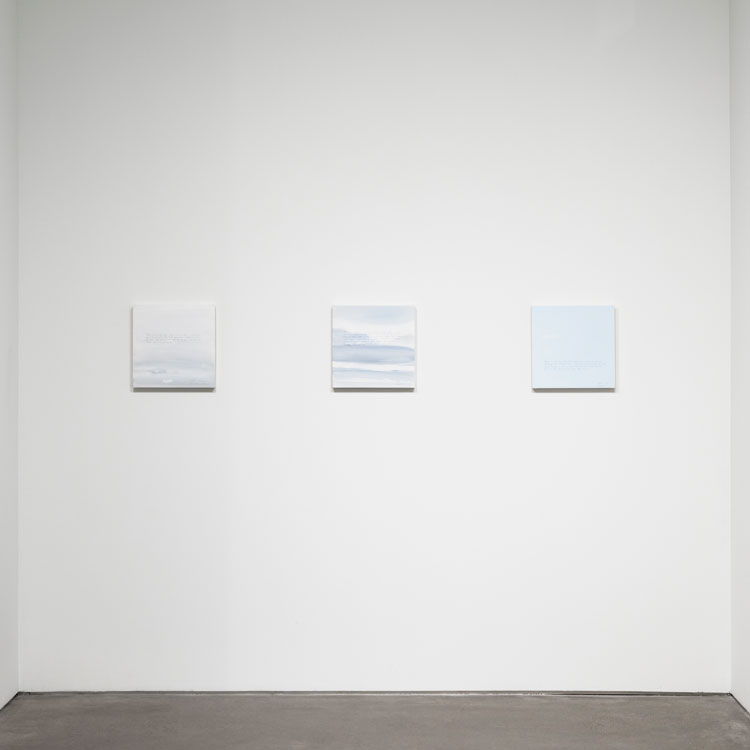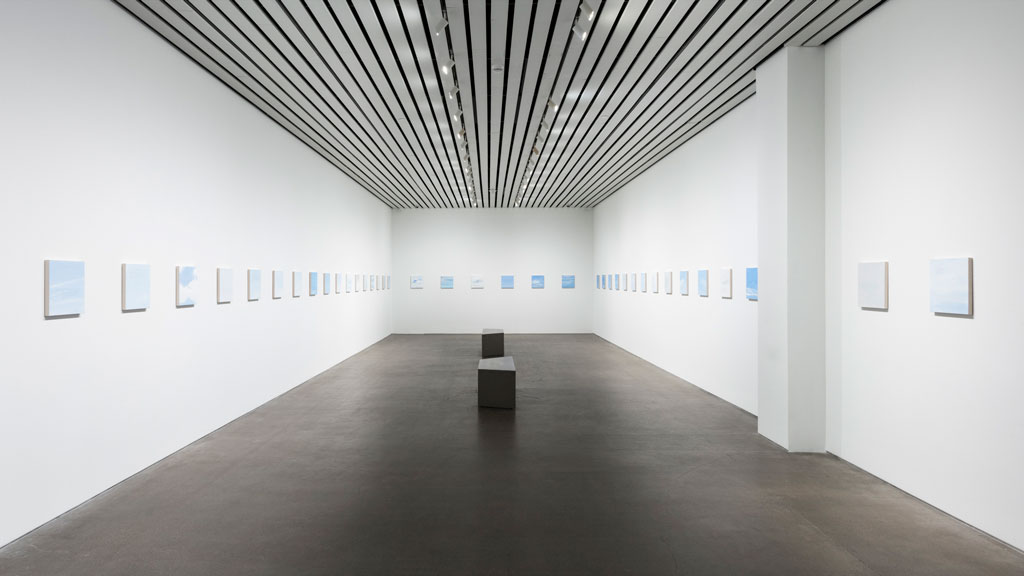Some people say the sky is just the sky
— Paul Simon, “Obvious Child”
But I say
Why deny the obvious, child?
Why deny the obvious, child?
The gallery in the Museum of Contemporary Art Cleveland currently devoted to Byron Kim (NA 2018) and his Sunday Paintings is compelling at just a glance—a whole room ringed with identically-sized paintings of the sky? A person may do something by accident once. Twice and it probably has some kind of intention behind it. With even more repetitions it must be somehow necessary or significant, backed by the weight of ritual and discipline. The many paintings have got to mean something. Following that first glimpse, the exhibition’s introductory text reveals that Kim has been making a painting of the sky every Sunday since early 2001. On each canvas he writes by hand the date, his current location, and a few sentences describing recent events in his life or his present state of mind. The 48 canvases on view are only a small portion of a series that numbers over 800 and is still growing. All of this can really get your mind racing.

I’ll discuss the particularities of the paintings shortly, but first it’s worth acknowledging Kim’s very steadfastness itself. Every Sunday setting himself in front of a 14-by-14 inch canvas. Every Sunday choosing a section of the sky to record, and then mixing paint to match it. Every Sunday pulling out a pen and coming up with something to write. Taking these materials with him while traveling away from his home in New York City, as far as California, South Korea, and China. For the past 18 years and more. Since last January 7th, the ongoing series has been old enough to vote. It’s common for a retrospective exhibition, or even a mid-career one-artist show, to encompass work made over a similarly long span, but Kim’s steady, dedicated repetition and the paintings’ arrangement in an unbroken and chronologically ordered line around the gallery bring the passage of time to the fore.
Of course, I say “every Sunday” but sometimes Kim has gotten a little off schedule. His note on Sunday Painting 12/8/16 reads: “This is as late as I’ve made a Sunday painting in a while. Thursday.” The many inscriptions make it clear that the artist lives a full life in which it is difficult to keep the series’s production unfailingly regular. But, since the prototypical “Sunday painter” is an amateur with other responsibilities who can only find time for art making on the weekends, this seems fitting—even a professional painter has to carve out time to maintain a personal project that breaks the week’s continuous rhythm. Kim’s rare breaches of conceptual protocol and (perhaps more importantly) his forthright admissions of them prevent his project from seeming too rigid to properly reflect lived experience in all its messiness.

More broadly, Kim seems quite willing to share his life candidly in his diary-style captions. They offer a flowing medley of movies, basketball games, kids’ college applications, studio work, pie, piano playing, taxes, dropping the kids off at college, meditation, talk radio, cooking, traveling, teaching, tea, homesickness, long walks, errands, and more. A poignant signal of authenticity and openness comes in Sunday Painting 4/20/14: “Lately I have been feeling really down. I wake up every morning with it, and I’m afraid to tell Lisa about it because winter is over.” Lisa is the artist Lisa Segal, Kim’s wife. Though he confides in her by the next week’s canvas, and even though that revelation happened more than five years ago, when I read this inscription it still felt like truly private information, very generously shared. Mood and depression come up many times in the Sunday Paintings, and if any lesson can be generalized from Kim’s experience, it’s that being with people—friends and family—is an effective remedy. Gatherings and good conversations always cheer the artist up. The April 20th note indeed continues: “But this morning I woke up feeling pretty good. Maybe it was last night’s dinner party.” This is a common sort of turn for the paintings—in Kim’s humble and quotidian narration of his own life, all of the little things that I listed above have the potential to shape both the course of events and the tone with which they carry onward.

Kim’s inscriptions are so forthright and create such a soothing rhythm that it’s easy to go through the gallery reading one after another without paying much attention to anything else. I found it helpful to occasionally step back far enough for the writing to become illegible, just a faint visual element and a general suggestion of weekly events, so that I could also be sure to focus on the painted skies. These really shouldn’t be overlooked. Kim became famous for precisely matching tones in paint to tones in skin, and his skies, too, seem very carefully observed. Like the panels in his well-known Synecdoche, 1991 – Present, they conform to no preconceptions or demarcated categories. Clouds with the sort of archetypal, puffy shapes that one would draw in a quick sketch or interpret while lying on a picnic blanket are rare, easily outnumbered by monochromes and near-monochromes, unformed fogs, thin wisps, thick but uneven covers, and patchy fuzzes. Amid this diversity, pairs of panels that look alike can easily turn out to be from entirely different seasons—try 6/7/15 and 11/25/15, both very light blue, lighter towards the bottom, and lacking clearly-formed clouds, but painted in Brooklyn during summer and early winter respectively. Across the series, colors range from richly saturated tones that are nearly purple to greener hues that look like tropical water, overriding any presumption of a singular “sky blue.” Kim’s brushwork varies too—10/29/17 and 11/5/17 are each solidly gray, but the first is softly and evenly applied while the second shows a multitude of rapid strokes. In 11/12/17 the artist comments: “Even though it’s not too windy down here, the clouds are moving fast and I’m just guessing.” Quick painting often suggests a quickly moving subject, but here the connection is tighter and more immediate: quick movement necessitated quick painting. This makes Kim’s pictures an especially direct index of so many Sunday skies, some that could be rendered slowly, some that demanded fast work, each full of idiosyncrasies.

Now that I’ve considered the painted and written portions of the Sunday Paintings separately, how can the two be brought together? Earlier reviews of the series have interpreted the skies as an indifferent or essentially changeless backdrop for Kim’s ever-progressing life. One could reverse the relationship and say that Kim is himself unaffected by the weather—he has certainly found himself in pessimistic moods on sunny days and felt great under cloudy conditions. But these seem like non-answers that dodge my original question. I have a hard time accepting that two things can be on the same canvas together without bearing some significant relationship. A crucial point, then, might be made in acknowledging the deceptively simple fact that in order to write out a caption in pen on top of a painting of the sky, Kim first has to paint the painting. He has to break away from other obligations, focus on a subject that is likely entirely different and celestial in scale, and perform a brief but concentrated and laborious task. Only after this can he make his inscription. The endearingly calm, gentle, and modest tone of Kim’s writing in the Sunday Paintings could perhaps be a simple product of his personality, but my suspicion is that it is inflected by these weekly encounters with the sky that must come first. The heavens are frequently described as an awesome expanse with the power to make us feel small and insignificant, but Kim’s work shows that there are other gracious ways to look both upward and inward.

Byron Kim: The Sunday Paintings is presented at the Museum of Contemporary Art Cleveland September 13, 2019 – January 5, 2020.
Jeffrey Katzin is a Curatorial Fellow at the Akron Art Museum and a doctoral candidate at the University of Pennsylvania, currently working on a dissertation project concerning the history and potential of abstract photography. He is particularly interested in abstract art and its capacities to convey political, philosophical, and personal meaning.
